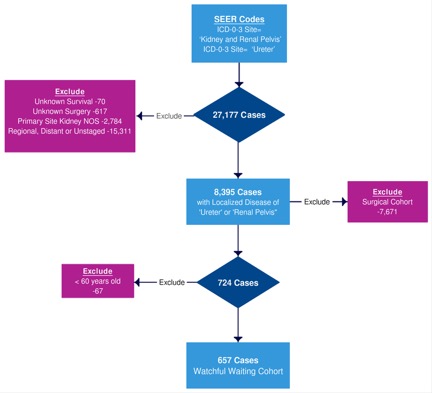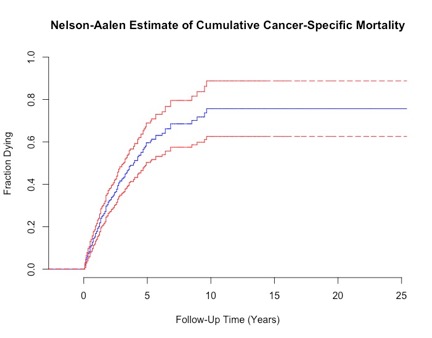| NEAUA Main Site | | | Past & Future Meetings |
|

|
Survival Outcomes for Patients with Localized Upper Tract Urothelial Carcinoma Managed with Watchful Waiting Jamil S. Syed, MD1, Kevin A. Nguyen, MS1, Katelyn Johnson, BS1, Ansh Bhagat, BS1, Jay Raman, MD2, Brian Shuch, MD1. 1Yale Department of Urology, New Haven, CT, USA, 2Pennsylvania State University, Hershey, PA, USA.
BACKGROUND: Often individuals with upper tract urothelial carcinoma (UTUC) are elderly and have comorbidities and may not be candidates for surgical intervention. Currently the outcome with “watchful waiting” in this population is unknown. METHODS: We utilized the Surveillance, Epidemiology, and End Results (SEER) database to identify individuals with a localized, histologically confirmed kidney/renal pelvis and ureteral urothelial carcinoma. Cases were excluded if surgical status or survival were unknown. Survival analysis using the Kaplan Meier method was performed between groups based on surgical status and tumor grade. A competing risk model was used to evaluate the cumulative incidence of cancer specific mortality (CSM) and predictors of CSM. RESULTS: There were 8,328 patients included, and 657 (7.9%) did not receive surgery. Patients without surgery were older (median age, 79 vs 71 p<0.001) and had smaller tumors (mean size, 2.9 cm vs 3.5 cm, p<0.001). The 3-year disease-specific survival (DSS) for patients without surgery was significantly lower compared to those with surgery, (70.8% vs. 90.4%, respectively, p<0.001). 2-year DSS for patients with high grade tumors was worse than for low grade tumors (65.0% vs. 84.8%, respectively, p<0.0001). The 5-year cumulative CSM was 58% overall and on multivariable analysis, older age (Hazard ratio (HR), 1.039 p<0.001) and high tumor grade (HR 2.03, p<0.0001) were predictors of worse outcome. CONCLUSIONS: A significant number of patients are offered a “watchful waiting approach” for UTUC. These patients are older with smaller disease burden. CSM is over 50% at 5 years. Older age and high grade disease portend worse prognosis. Back to 2017 Program |
|
Photos courtesty of Old Port of Montréal © Tourisme Montréal, Stéphan Poulin.







